On Monday June 14, the day I rode from Flagstaff, the high temperature in Phoenix hit 118°F.
As it would every day for the rest of the week.
Family and friends wondered why the bloody hell I'd come back to Phoenix given my intense and well-known aversion to such conditions.
I assumed soaring in that kind of temperature would not be much fun, and after the ride down was inclined to do little but sit in the air conditioning and watch TV with mom. But I also assumed the heat would make for great thermals, and a glance at the NOAA/NWS Soaring Forecast seemed to bear that out: the “thermal index” at 5000 feet MSL was -11.
The more negative the thermal index the better; -3 is the bare maximum for usable lift.
-11 was the best I’d ever seen.
I pinged Sasha and asked him how he felt about soaring in such temperatures; he replied he enjoyed flying at 110-120° and reminded me the air gets cooler at higher altitudes.
Tony, on the other hand, felt anything above 110° was intolerable. He commented he wasn’t flying check rides after 9:00 AM.
I thought I might go out and fly in the mornings, and call it quits before the heat got extreme.
But the next day’s thermal index forecast was surprisingly poor…as it was day after day after day. This puzzled me, but I suppose once the entire freaking desert and the air above it become uniformly superheated, no one spot is significantly warmer than any other, thus no temperature differentials, thus no “instability”, which is what thermal index enumerates. Irrespective of cockpit comfort, if the forecast was correct flying would be an exercise in frustration; a glider would perform only slightly better than a streamlined brick suspended from a parachute.
*
While flying seemed pointless I had something else to occupy my time: solving Therese’s poor low speed/low RPM problem.
After her misbehavior in Colorado (and in Flagstaff, and during the last few miles returning to mom’s house, where the engine died as I pulled into the driveway…engendering no surprise but plenty of disgust on my part) I needed to do something.
One possibility was to ride directly to MotoGhost, a shop of excellent repute just minutes from mom’s house that caters exclusively to BMW motorcycles. I could simply instruct them to “figure out the f*****g problem”, and then hope 1) they would succeed, unlike everywhere else I’d ever tried that approach, and 2) that such an open-ended exploration wouldn’t cost a fortune; all the other times I’d issued such an instruction, the bike had still been on warranty.
But before trying that…
I’d long considered buying a fault code reader so I could interrogate Therese’s multiple computer subsystems myself. If ever there was a good time, this was it, so one of the first things I did when I got to mom’s house was order a “GS-911”. As soon as it arrived I ran a scan and found 13 distinct fault codes.
The large volume of faults was no surprise. I perform as much of my own maintenance and repair as possible and had at this point eschewed dealer service for several years. Codes had been accumulating since Therese had last seen a mechanic equipped with a gizmo capable of clearing them.
Most codes were a variety of “low voltage” fault. This made perfect sense considering the complete battery discharge that had happened because I’d plugged the charger into the wrong connector when I’d last stored the bike in March of 2020. The first maintenance action I performed in 2021 was to install a fresh battery; the second was to remove that connector and the accessory socket it powered. I'd installed the socket a couple years earlier, but to date had never used it to do anything but run the battery dead flat.
Code “10049: Incorrect oil level detected - possibly over filled (level above maximum)” was also unsurprising. While Therese’s specific oil consumption has never been considered “excessive” per BMW spec, the need to top up has always been an inconvenience while engaged in transcontinental travel. I’d been assured by the service manager of the dealer who sold me the bike that overfilling the “dry sump” system’s oil tank would cause no damage, so I always made sure it was plenty full before starting a tour.
“41739: Horn malfunction, open circuit” was unexpected. Shortly after buying Therese I’d installed an aftermarket horn selected based on its rated output on the dbA scale. After seeing this fault code, I pushed the horn button and only the wimpy factory unit issued its signature plaintive bleep. I pulled the left side fairing panel and the failure cause was obvious: a spade connector to the Wolo had slipped completely off; I crimped it down with pliers for a tighter fit which fixed the problem, to the undoubted chagrin of mom's neighbors. I was impressed the fault logging system had identified failure of a completely foreign accessory even though the stock component was working exactly as designed.
But the code that really caught my eye was “10313: Exhaust flap servomotor”.
The “exhaust flap” is a butterfly valve in the exhaust pipe just upstream of the muffler. I’ve heard various theories about why it’s there, ranging from noise control to pre-heating the catalytic converter to managing exhaust system back-pressure during off-idle throttle conditions.
The GS-911 not only reads fault codes but can also clear them. I did so, then went for a short ride around the neighborhood during which Therese stalled multiple times while pulling up to stops.
I plugged in the GS-911 and read the fault codes again.
There was only one.
10313.
I wondered if any other mechanic had ever seen this code, and if so, what if anything they’d done about it.
I checked the price of an exhaust flap servo motor.
$302.00
I was disinclined to spend three bills to replace the part not because I’m a cheapskate (which I admit I am…a spendthrift at the very least), but because engine stalls when closing the throttle had been a problem with this motorcycle since the day I rode the machine out of the dealership.
Maybe this gadget had been the problem all along, even when it was new.
I’d also seen “internet wisdom” (an oxymoron if there ever was one) suggesting that simply disconnecting the control cable from the servo motor to the flap would leave the flap wide open all the time, as opposed to potentially almost completely blocking exhaust flow based on (possibly erroneous) instructions from the engine control computer to the (reportedly defective) servo motor.
I disconnected the cable, confirming that doing so indeed caused the device’s coil spring to hold the valve fully open.
I went for a test ride.
Time after time I’d pull up to a stop and expect the engine to stall.
And it didn’t.
I did detect a change in the engine’s off-idle torque, which seemed flat. But that wasn’t much of a sacrifice if the benefit was a motor that kept running until I hit the kill switch. Maybe a bigger problem was that the bike was now generally much noisier, and I’m not a fan of loud motorcycles.
At that point it made perfect sense to just ride over to MotoGhost and schedule an appointment. The instructions would not be to “figure out the f*****g problem”, but simply to give Therese a well-earned spa day: oil change, brake fluid change, cooling system flush. All stuff I’d have normally done myself, if it wasn’t a hundred and eighteen damn degrees. Not to mention dealing with the spent fluids.
I told Jeremy what I’d done with the exhaust flap, and that I was inclined to leave it that way.
He didn’t suggest I shouldn’t.
*
I still had Sue’s Prius at my disposal, which made it possible to visit friends in comfort. On Saturday I enjoyed lunch at Thai Rama with John and Lori – John being an old friend who’s a pilot and thus particularly interested in my soaring experiences.
That evening Gary and I ate Mexican at El Encanto Dos, then went back to his place where I noodled on bass while he played one of his many guitars. It was the first time in all the years I’ve known him that we’ve jammed together.
*
Monday evening I enjoyed takeout from Thai Thai Kitchen with long-time BMW riding buddies Jan and Craig. I met their deaf dog Horace who understands hand signals, which is an extremely cool thing to experience.
*
When Therese and I rode into the MotoGhost lot on Tuesday morning, Larry and Gary were already there, having arrived in Larry’s Lexus. While Therese enjoyed her spa day, we drove to Jerome via the “back way” (over Mingus Mountain, coming into Jerome from the west).
As it would every day for the rest of the week.
Family and friends wondered why the bloody hell I'd come back to Phoenix given my intense and well-known aversion to such conditions.
I assumed soaring in that kind of temperature would not be much fun, and after the ride down was inclined to do little but sit in the air conditioning and watch TV with mom. But I also assumed the heat would make for great thermals, and a glance at the NOAA/NWS Soaring Forecast seemed to bear that out: the “thermal index” at 5000 feet MSL was -11.
The more negative the thermal index the better; -3 is the bare maximum for usable lift.
-11 was the best I’d ever seen.
I pinged Sasha and asked him how he felt about soaring in such temperatures; he replied he enjoyed flying at 110-120° and reminded me the air gets cooler at higher altitudes.
Tony, on the other hand, felt anything above 110° was intolerable. He commented he wasn’t flying check rides after 9:00 AM.
I thought I might go out and fly in the mornings, and call it quits before the heat got extreme.
But the next day’s thermal index forecast was surprisingly poor…as it was day after day after day. This puzzled me, but I suppose once the entire freaking desert and the air above it become uniformly superheated, no one spot is significantly warmer than any other, thus no temperature differentials, thus no “instability”, which is what thermal index enumerates. Irrespective of cockpit comfort, if the forecast was correct flying would be an exercise in frustration; a glider would perform only slightly better than a streamlined brick suspended from a parachute.
*
While flying seemed pointless I had something else to occupy my time: solving Therese’s poor low speed/low RPM problem.
After her misbehavior in Colorado (and in Flagstaff, and during the last few miles returning to mom’s house, where the engine died as I pulled into the driveway…engendering no surprise but plenty of disgust on my part) I needed to do something.
One possibility was to ride directly to MotoGhost, a shop of excellent repute just minutes from mom’s house that caters exclusively to BMW motorcycles. I could simply instruct them to “figure out the f*****g problem”, and then hope 1) they would succeed, unlike everywhere else I’d ever tried that approach, and 2) that such an open-ended exploration wouldn’t cost a fortune; all the other times I’d issued such an instruction, the bike had still been on warranty.
But before trying that…
I’d long considered buying a fault code reader so I could interrogate Therese’s multiple computer subsystems myself. If ever there was a good time, this was it, so one of the first things I did when I got to mom’s house was order a “GS-911”. As soon as it arrived I ran a scan and found 13 distinct fault codes.
The large volume of faults was no surprise. I perform as much of my own maintenance and repair as possible and had at this point eschewed dealer service for several years. Codes had been accumulating since Therese had last seen a mechanic equipped with a gizmo capable of clearing them.
Most codes were a variety of “low voltage” fault. This made perfect sense considering the complete battery discharge that had happened because I’d plugged the charger into the wrong connector when I’d last stored the bike in March of 2020. The first maintenance action I performed in 2021 was to install a fresh battery; the second was to remove that connector and the accessory socket it powered. I'd installed the socket a couple years earlier, but to date had never used it to do anything but run the battery dead flat.
Code “10049: Incorrect oil level detected - possibly over filled (level above maximum)” was also unsurprising. While Therese’s specific oil consumption has never been considered “excessive” per BMW spec, the need to top up has always been an inconvenience while engaged in transcontinental travel. I’d been assured by the service manager of the dealer who sold me the bike that overfilling the “dry sump” system’s oil tank would cause no damage, so I always made sure it was plenty full before starting a tour.
“41739: Horn malfunction, open circuit” was unexpected. Shortly after buying Therese I’d installed an aftermarket horn selected based on its rated output on the dbA scale. After seeing this fault code, I pushed the horn button and only the wimpy factory unit issued its signature plaintive bleep. I pulled the left side fairing panel and the failure cause was obvious: a spade connector to the Wolo had slipped completely off; I crimped it down with pliers for a tighter fit which fixed the problem, to the undoubted chagrin of mom's neighbors. I was impressed the fault logging system had identified failure of a completely foreign accessory even though the stock component was working exactly as designed.
But the code that really caught my eye was “10313: Exhaust flap servomotor”.
The “exhaust flap” is a butterfly valve in the exhaust pipe just upstream of the muffler. I’ve heard various theories about why it’s there, ranging from noise control to pre-heating the catalytic converter to managing exhaust system back-pressure during off-idle throttle conditions.
The GS-911 not only reads fault codes but can also clear them. I did so, then went for a short ride around the neighborhood during which Therese stalled multiple times while pulling up to stops.
I plugged in the GS-911 and read the fault codes again.
There was only one.
10313.
I wondered if any other mechanic had ever seen this code, and if so, what if anything they’d done about it.
I checked the price of an exhaust flap servo motor.
$302.00
I was disinclined to spend three bills to replace the part not because I’m a cheapskate (which I admit I am…a spendthrift at the very least), but because engine stalls when closing the throttle had been a problem with this motorcycle since the day I rode the machine out of the dealership.
Maybe this gadget had been the problem all along, even when it was new.
I’d also seen “internet wisdom” (an oxymoron if there ever was one) suggesting that simply disconnecting the control cable from the servo motor to the flap would leave the flap wide open all the time, as opposed to potentially almost completely blocking exhaust flow based on (possibly erroneous) instructions from the engine control computer to the (reportedly defective) servo motor.
I disconnected the cable, confirming that doing so indeed caused the device’s coil spring to hold the valve fully open.
I went for a test ride.
Time after time I’d pull up to a stop and expect the engine to stall.
And it didn’t.
I did detect a change in the engine’s off-idle torque, which seemed flat. But that wasn’t much of a sacrifice if the benefit was a motor that kept running until I hit the kill switch. Maybe a bigger problem was that the bike was now generally much noisier, and I’m not a fan of loud motorcycles.
At that point it made perfect sense to just ride over to MotoGhost and schedule an appointment. The instructions would not be to “figure out the f*****g problem”, but simply to give Therese a well-earned spa day: oil change, brake fluid change, cooling system flush. All stuff I’d have normally done myself, if it wasn’t a hundred and eighteen damn degrees. Not to mention dealing with the spent fluids.
I told Jeremy what I’d done with the exhaust flap, and that I was inclined to leave it that way.
He didn’t suggest I shouldn’t.
*
I still had Sue’s Prius at my disposal, which made it possible to visit friends in comfort. On Saturday I enjoyed lunch at Thai Rama with John and Lori – John being an old friend who’s a pilot and thus particularly interested in my soaring experiences.
That evening Gary and I ate Mexican at El Encanto Dos, then went back to his place where I noodled on bass while he played one of his many guitars. It was the first time in all the years I’ve known him that we’ve jammed together.
*
Monday evening I enjoyed takeout from Thai Thai Kitchen with long-time BMW riding buddies Jan and Craig. I met their deaf dog Horace who understands hand signals, which is an extremely cool thing to experience.
*
When Therese and I rode into the MotoGhost lot on Tuesday morning, Larry and Gary were already there, having arrived in Larry’s Lexus. While Therese enjoyed her spa day, we drove to Jerome via the “back way” (over Mingus Mountain, coming into Jerome from the west).
We had lunch, and returned to Phoenix at precisely the moment Therese was getting her post-service test ride.
*
Wednesday looked like it might be a flying day – at least the temperature was finally going to break, with a projected high under 90°F. But when I awoke and checked the soaring forecast, the numbers were all "0.0". I didn’t know what to make of that, but it didn’t encourage me to call Estrella to reserve a sailplane. Then it rained, an actual measurable amount, for the first time in months.
It was a nice day to just hang out with mom.
*
Thursday morning’s forecast thermal index was -6.5, with a high temperature barely into triple digits. I immediately called the sailport and left a message. Just after 11:00 Jason returned my call: yes, a glider would be available by the time I got my act together and drove to Estrella.
I was pleased to find good ol’ 42Tango was my ship for the day. Planning the tow, Daniel suggested he’d simply drive me over to the lift, which would be found directly under a small cumulus cloud northwest of the sailport.
It had been a month since I’d last flown, and I felt rusty. Takeoff of my first flight as a rated pilot was a bit rough in a gusty crosswind. Above Sevenmile Mountain I was bouncing around so much I figured this must be the place and cut myself loose far below the altitude I’d initially suggested to Daniel.
From a 2400 AGL release I flew for an hour and a quarter in various thermals. It was one of my longest flights. There was a lot of up and down as I repeatedly poked around looking for lift, finding it, then losing it. For quite some time I tried to work the same thermal as someone in a much higher-performance ship high above me, but with limited success. In the end I eked out a maximum gain of more than 1800 feet.
The landing was not my best ever; my final approach was too short and steep and thanks in part to a crosswind gust I was a bit misaligned and bounced off the runway before I got everything into what after that was really good shape. I stopped right at the sock, wings level.
I probably could have stayed up longer but should have come down sooner; at one point I’d lost a thermal I’d been working and descended almost to pattern altitude. I was ready to go for landing when I suddenly picked up very strong lift, and it was the thermal that ultimately took me highest.
The whole time I was keeping a close eye on a storm that initially seemed to be moving toward Estrella from the southwest; I was ready to get down fast if it got closer, but it moved east instead and so I kept flying. Still, it was kind of close and I should have been more prudent.
Jason was in the flight center and I debriefed with him; he reminded me "no thermalling under 2800" (MSL). In other words, no working thermals at less than 500 feet above pattern altitude – no doing anything but preparing to land – because there’s too much chance that finding a bit of lift could be followed by flying into a lot of sink, and then with insufficient ability to safely return to the runway. He also gave me the usual advice about improving my control during landing.
On the ground it was clear the storm was too close for any more flying, and we put 42T back in the hangar.
*
Back in the Prius I called friends who live in San Tan Valley; this trip to Estrella was about as close as I’d likely get to Karen & Ken’s place. I’d been remiss in contacting them earlier, but this was really the first time I’d been at Estrella with an open evening ahead of me. I was prepared for it not to be a good day to visit, but in fact it was the opposite; the grandkids were coming over for a pizza and pool party, and I was more than welcome to join.
I’d brought my swim suit against that possibility.
It was fun to splash around with the kiddies, a very relaxing evening.
*
I started toward home by driving north across the far east valley. Eventually I’d reach Apache Trail and hang a left.
For my travel music I’d selected a playlist which, at that time, was a series of threnodies from Alanis Morrisette’s Flavors of Entanglement album.
The mood was melancholy, reflective, pensive.
Beyond the car windows was something that wasn’t quite emptiness. Bleak flat expanses of often barren cropland, occasionally interrupted by artifacts ranging from isolated irrigation pumps and stock pens to distant, enormous industrial complexes of unknown purpose. Without exception these structures were nothing but two-dimensional gray shapes which it kinda seemed should have already been illuminated by night lights but for some reason hadn’t. All was gloomy against the darkening landscape and twilight sky, which was the opposite of the spectacular sunsets from which the Arizona state flag was inspired. The western sky was uncharacteristically drab; above the silhouettes of distant mountains and cloud banks was an ocher band of smudgy murk and deepening degrees of darkness which weren’t at any point a shade of blue.
All the lights had finally come on by the time I reached US-60, from which I exited to AZ-202 because it has curves. The night sky had been fully vanquished as I approached Tempe, which has become a new and continuously growing mountain of glittering alloy and glass and light, bearing no resemblance to what existed when I attended Arizona State University in the early 80s, or when Laurel and I lived in the area through most of that decade.
At the last moment I decided to cruise Mill Avenue. Had I not indulged this whim, I wouldn’t have been descending the exit ramp and looking east just in time to see an enormous full Moon detach itself from the horizon.
Amidst all the changes to downtown Tempe it was good to see that a portion of the historic La Casa Vieja still stands, as do the towering silos of the Hayden flour mill. I was aware these historic buildings are a thorn in the side of an army of soulless real estate moguls who’d prefer to raze them and erect yet more ultra-modern and ultra-pricey structures in their place.
The continued existence of these irritants to the proponents of unrestrained development raised my spirits, as did a surprisingly colorful – as in people of color – night life that I hadn't expected, especially when school was definitely out for the summer.
After driving randomly around Tempe for a while I ended up on campus, where I parked in defiance of the posted requirement to either display a permit or pay the meter. It was a safe bet I wouldn’t collect a ticket in an empty lot rather late on a Thursday night when the university appeared to be solidly closed up.
I strolled around the campus, which has morphed unrecognizably around the nuclei of buildings I once haunted. They were sometimes hard to find, sometimes (due to construction) almost impossible to get to, but I meandered past the engineering complex, the physics building, Hayden library, Memorial Union, the layer-cake music building, and finally Grady Gammage Auditorium, one of Frank Lloyd Wright’s last public projects. Ascending one of the auditorium's flying ramps to the balcony level, I took pictures of the Moon juxtaposed with the ramp's iconic globe lamps.
*
Wednesday looked like it might be a flying day – at least the temperature was finally going to break, with a projected high under 90°F. But when I awoke and checked the soaring forecast, the numbers were all "0.0". I didn’t know what to make of that, but it didn’t encourage me to call Estrella to reserve a sailplane. Then it rained, an actual measurable amount, for the first time in months.
It was a nice day to just hang out with mom.
*
Thursday morning’s forecast thermal index was -6.5, with a high temperature barely into triple digits. I immediately called the sailport and left a message. Just after 11:00 Jason returned my call: yes, a glider would be available by the time I got my act together and drove to Estrella.
I was pleased to find good ol’ 42Tango was my ship for the day. Planning the tow, Daniel suggested he’d simply drive me over to the lift, which would be found directly under a small cumulus cloud northwest of the sailport.
It had been a month since I’d last flown, and I felt rusty. Takeoff of my first flight as a rated pilot was a bit rough in a gusty crosswind. Above Sevenmile Mountain I was bouncing around so much I figured this must be the place and cut myself loose far below the altitude I’d initially suggested to Daniel.
From a 2400 AGL release I flew for an hour and a quarter in various thermals. It was one of my longest flights. There was a lot of up and down as I repeatedly poked around looking for lift, finding it, then losing it. For quite some time I tried to work the same thermal as someone in a much higher-performance ship high above me, but with limited success. In the end I eked out a maximum gain of more than 1800 feet.
The landing was not my best ever; my final approach was too short and steep and thanks in part to a crosswind gust I was a bit misaligned and bounced off the runway before I got everything into what after that was really good shape. I stopped right at the sock, wings level.
I probably could have stayed up longer but should have come down sooner; at one point I’d lost a thermal I’d been working and descended almost to pattern altitude. I was ready to go for landing when I suddenly picked up very strong lift, and it was the thermal that ultimately took me highest.
The whole time I was keeping a close eye on a storm that initially seemed to be moving toward Estrella from the southwest; I was ready to get down fast if it got closer, but it moved east instead and so I kept flying. Still, it was kind of close and I should have been more prudent.
Jason was in the flight center and I debriefed with him; he reminded me "no thermalling under 2800" (MSL). In other words, no working thermals at less than 500 feet above pattern altitude – no doing anything but preparing to land – because there’s too much chance that finding a bit of lift could be followed by flying into a lot of sink, and then with insufficient ability to safely return to the runway. He also gave me the usual advice about improving my control during landing.
On the ground it was clear the storm was too close for any more flying, and we put 42T back in the hangar.
*
Back in the Prius I called friends who live in San Tan Valley; this trip to Estrella was about as close as I’d likely get to Karen & Ken’s place. I’d been remiss in contacting them earlier, but this was really the first time I’d been at Estrella with an open evening ahead of me. I was prepared for it not to be a good day to visit, but in fact it was the opposite; the grandkids were coming over for a pizza and pool party, and I was more than welcome to join.
I’d brought my swim suit against that possibility.
It was fun to splash around with the kiddies, a very relaxing evening.
*
I started toward home by driving north across the far east valley. Eventually I’d reach Apache Trail and hang a left.
For my travel music I’d selected a playlist which, at that time, was a series of threnodies from Alanis Morrisette’s Flavors of Entanglement album.
The mood was melancholy, reflective, pensive.
Beyond the car windows was something that wasn’t quite emptiness. Bleak flat expanses of often barren cropland, occasionally interrupted by artifacts ranging from isolated irrigation pumps and stock pens to distant, enormous industrial complexes of unknown purpose. Without exception these structures were nothing but two-dimensional gray shapes which it kinda seemed should have already been illuminated by night lights but for some reason hadn’t. All was gloomy against the darkening landscape and twilight sky, which was the opposite of the spectacular sunsets from which the Arizona state flag was inspired. The western sky was uncharacteristically drab; above the silhouettes of distant mountains and cloud banks was an ocher band of smudgy murk and deepening degrees of darkness which weren’t at any point a shade of blue.
All the lights had finally come on by the time I reached US-60, from which I exited to AZ-202 because it has curves. The night sky had been fully vanquished as I approached Tempe, which has become a new and continuously growing mountain of glittering alloy and glass and light, bearing no resemblance to what existed when I attended Arizona State University in the early 80s, or when Laurel and I lived in the area through most of that decade.
At the last moment I decided to cruise Mill Avenue. Had I not indulged this whim, I wouldn’t have been descending the exit ramp and looking east just in time to see an enormous full Moon detach itself from the horizon.
Amidst all the changes to downtown Tempe it was good to see that a portion of the historic La Casa Vieja still stands, as do the towering silos of the Hayden flour mill. I was aware these historic buildings are a thorn in the side of an army of soulless real estate moguls who’d prefer to raze them and erect yet more ultra-modern and ultra-pricey structures in their place.
The continued existence of these irritants to the proponents of unrestrained development raised my spirits, as did a surprisingly colorful – as in people of color – night life that I hadn't expected, especially when school was definitely out for the summer.
After driving randomly around Tempe for a while I ended up on campus, where I parked in defiance of the posted requirement to either display a permit or pay the meter. It was a safe bet I wouldn’t collect a ticket in an empty lot rather late on a Thursday night when the university appeared to be solidly closed up.
I strolled around the campus, which has morphed unrecognizably around the nuclei of buildings I once haunted. They were sometimes hard to find, sometimes (due to construction) almost impossible to get to, but I meandered past the engineering complex, the physics building, Hayden library, Memorial Union, the layer-cake music building, and finally Grady Gammage Auditorium, one of Frank Lloyd Wright’s last public projects. Ascending one of the auditorium's flying ramps to the balcony level, I took pictures of the Moon juxtaposed with the ramp's iconic globe lamps.
No less than three times, other nocturnal wanderers complimented my favorite Hawaiian shirt – of course that’s what I’d worn to go flying!
Walking about on this warm night made me thirsty, so I walked downtown until I saw a sign with the word “brewery” in it.
Walking about on this warm night made me thirsty, so I walked downtown until I saw a sign with the word “brewery” in it.
*
Friday’s soaring forecast was only -4.5. As I’d barely been able to effectively exploit a thermal index of -6.5 the day before, I decided my flying was done for this trip.
Flight #101 was a fine note to end on.
*
Saturday I enjoyed another Thai lunch with John F., then hung out with Larry and Jana into the evening. Much of the afternoon was spent luxuriating among the fountains of Larry's custom-built pool, the Hillbillyagio.
On Sunday, Sue and Mom and I enjoyed a farewell feast. Sue had made a batch of my favorite chili recipe.
Saving outside tasks for the marginally cooler wee hours of Monday morning, I prepared Therese for storage, and packed Nada 3 for return to Michigan.
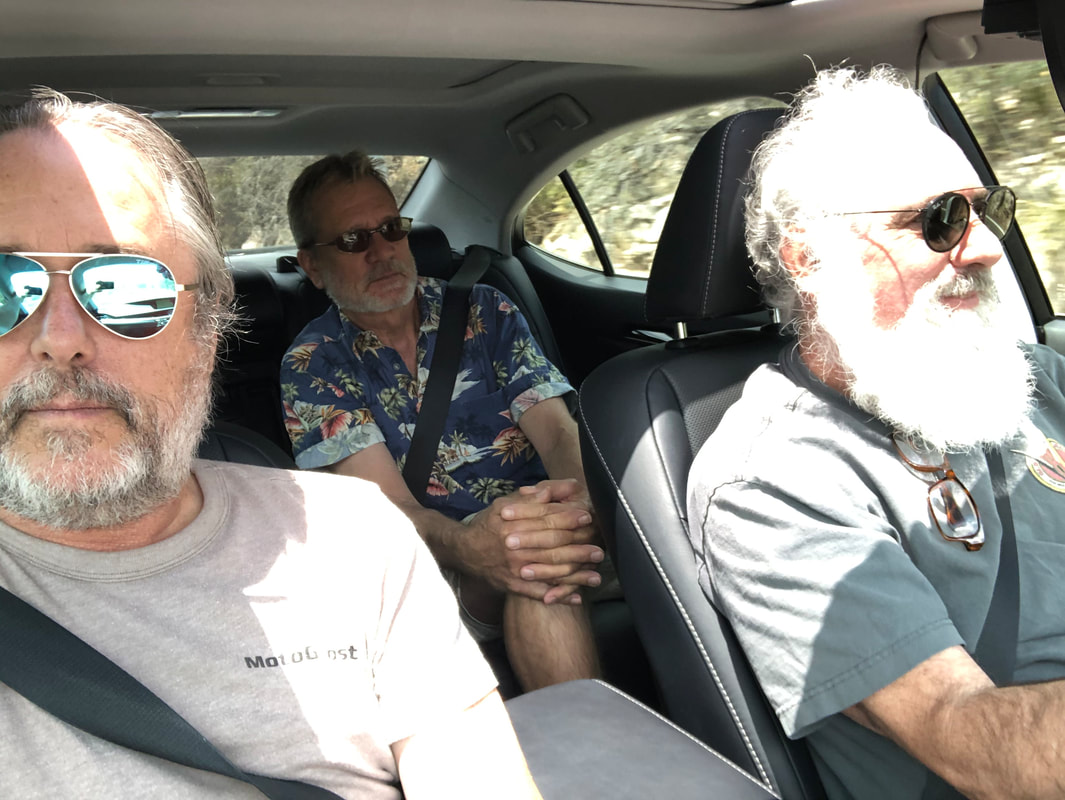
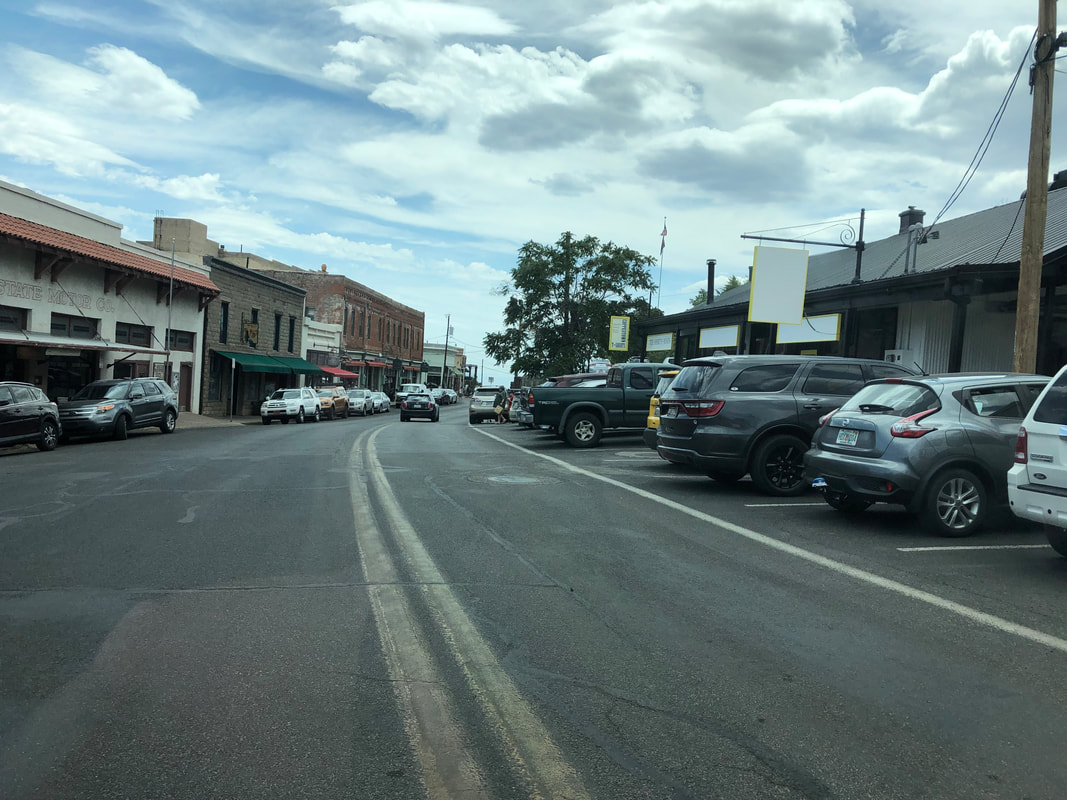
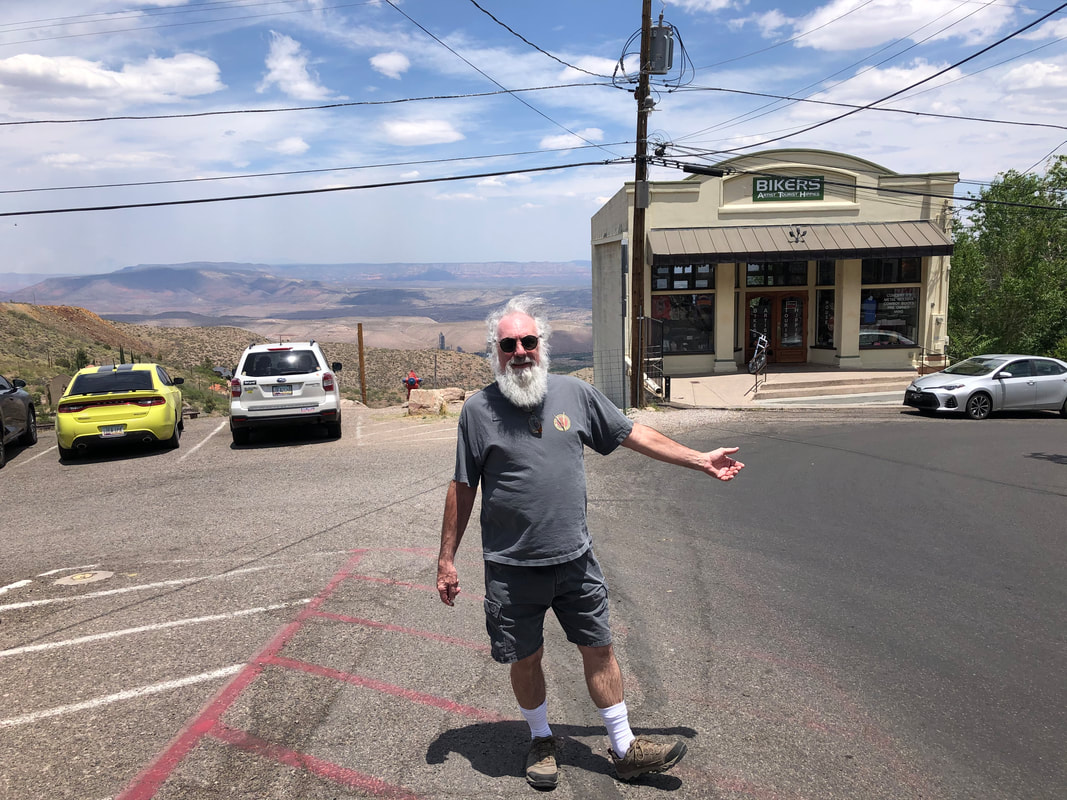
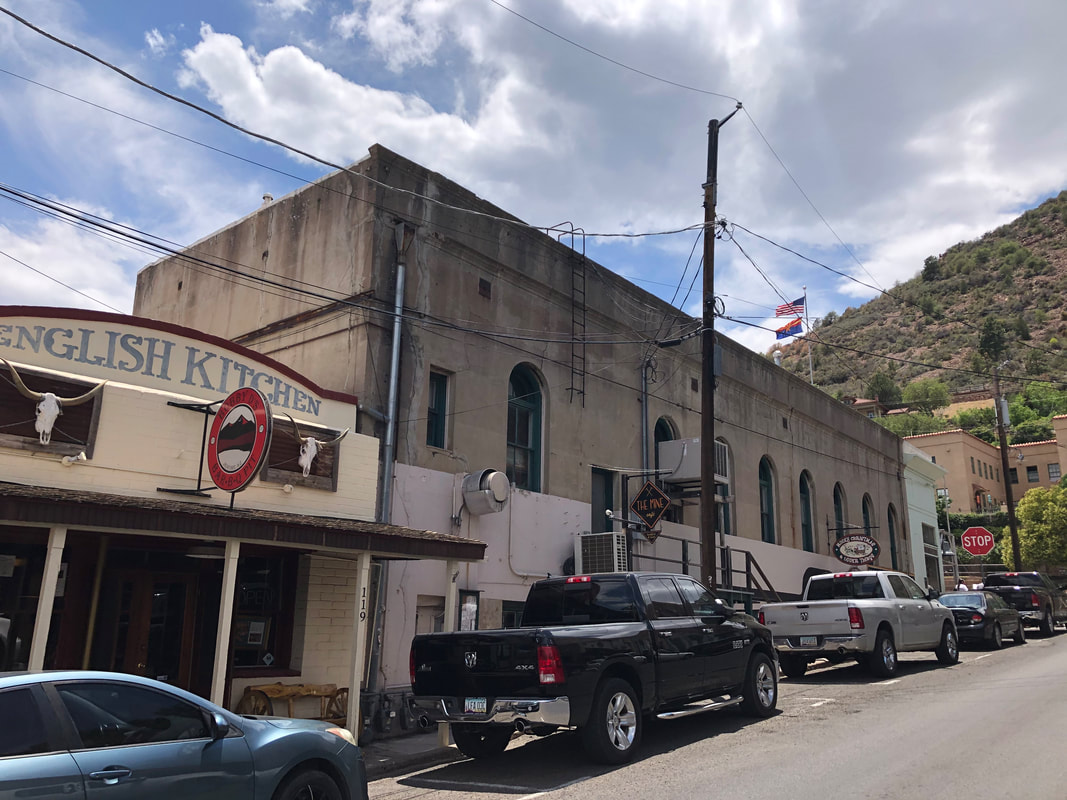
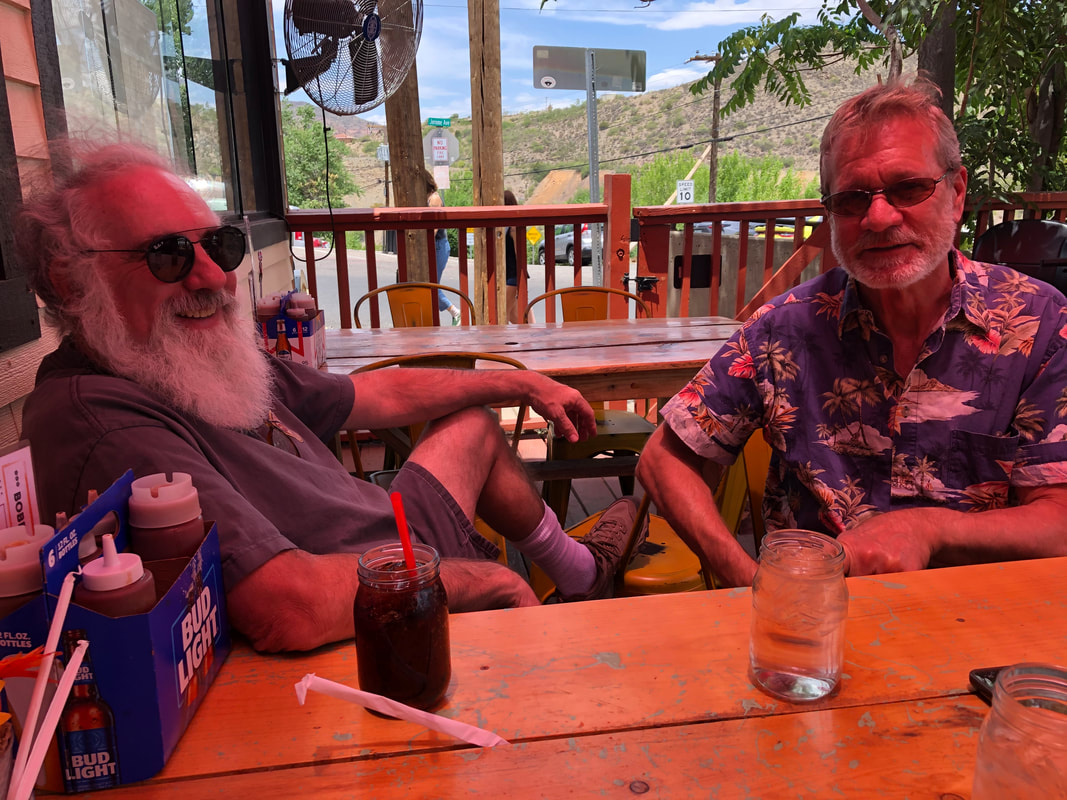
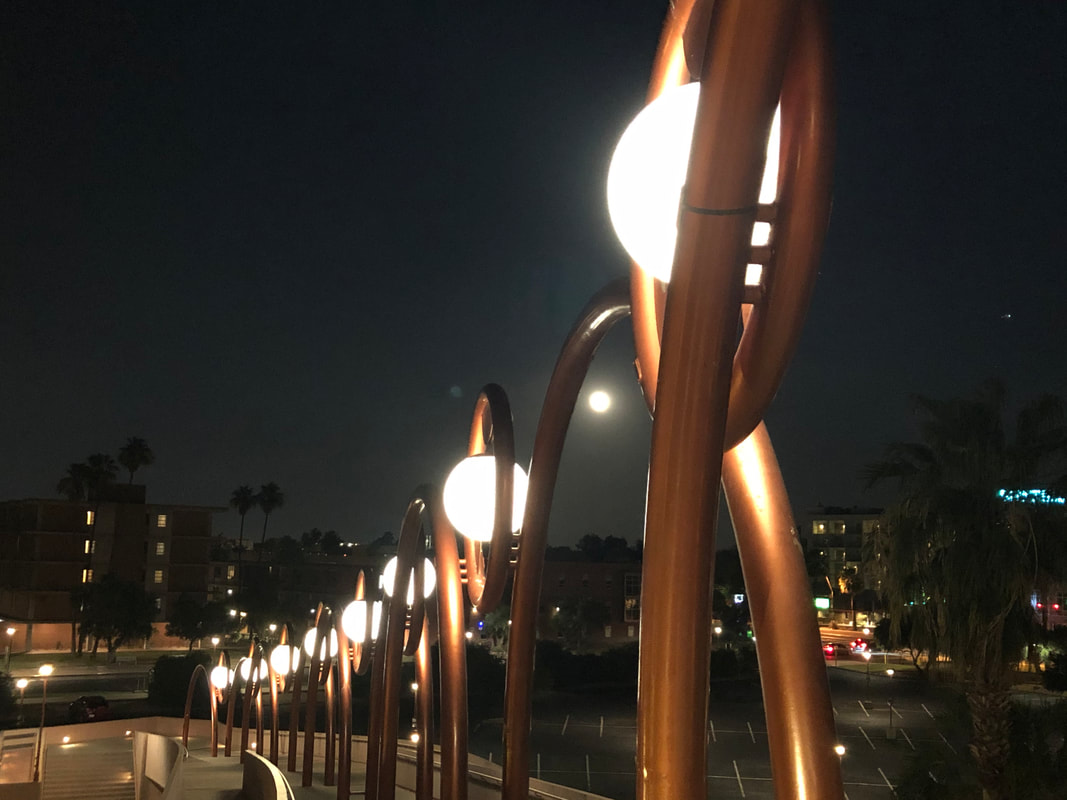
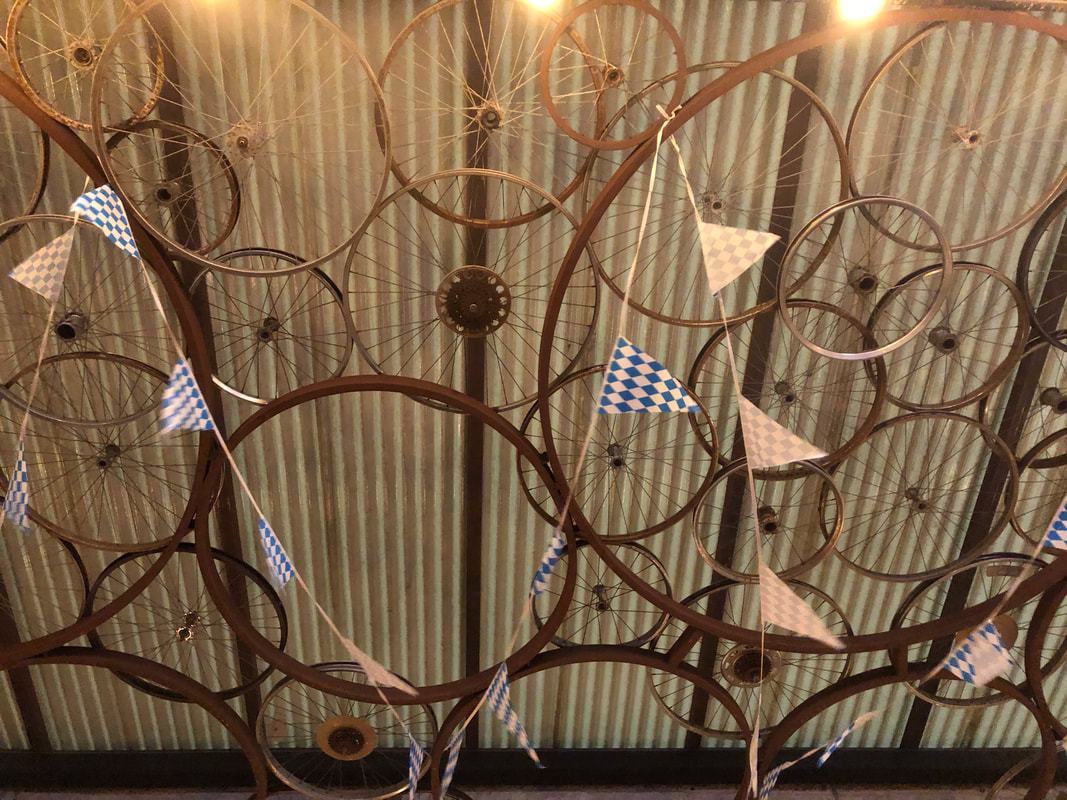
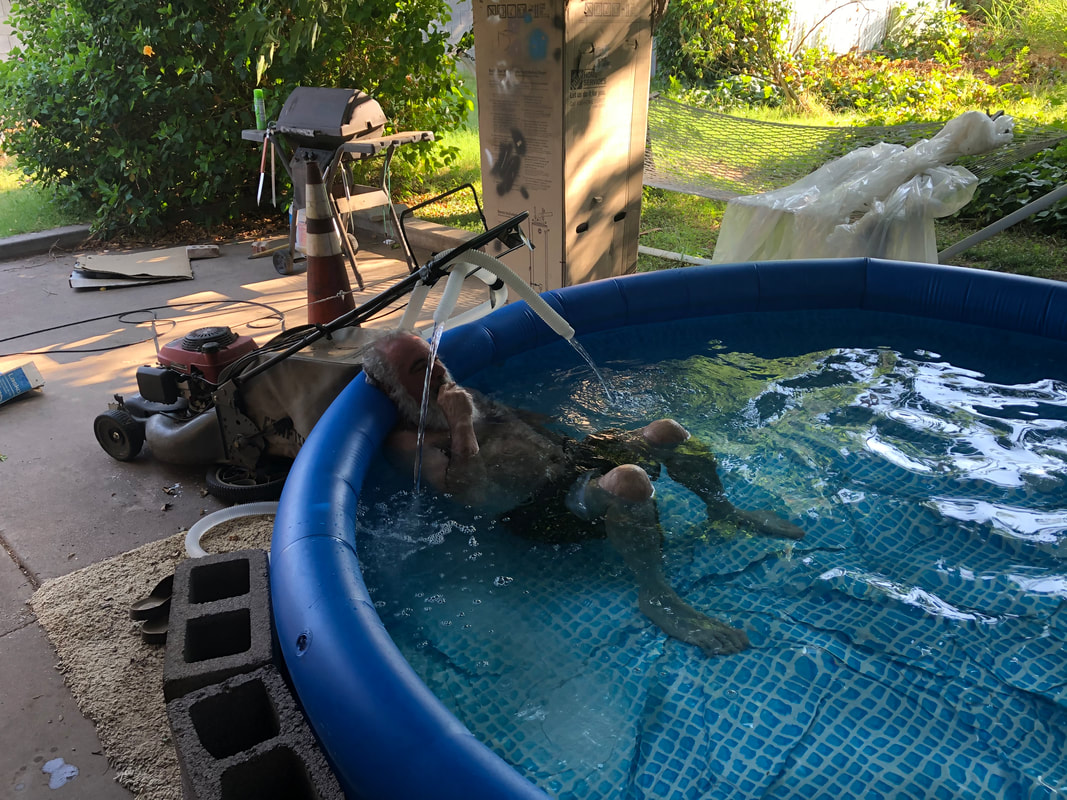
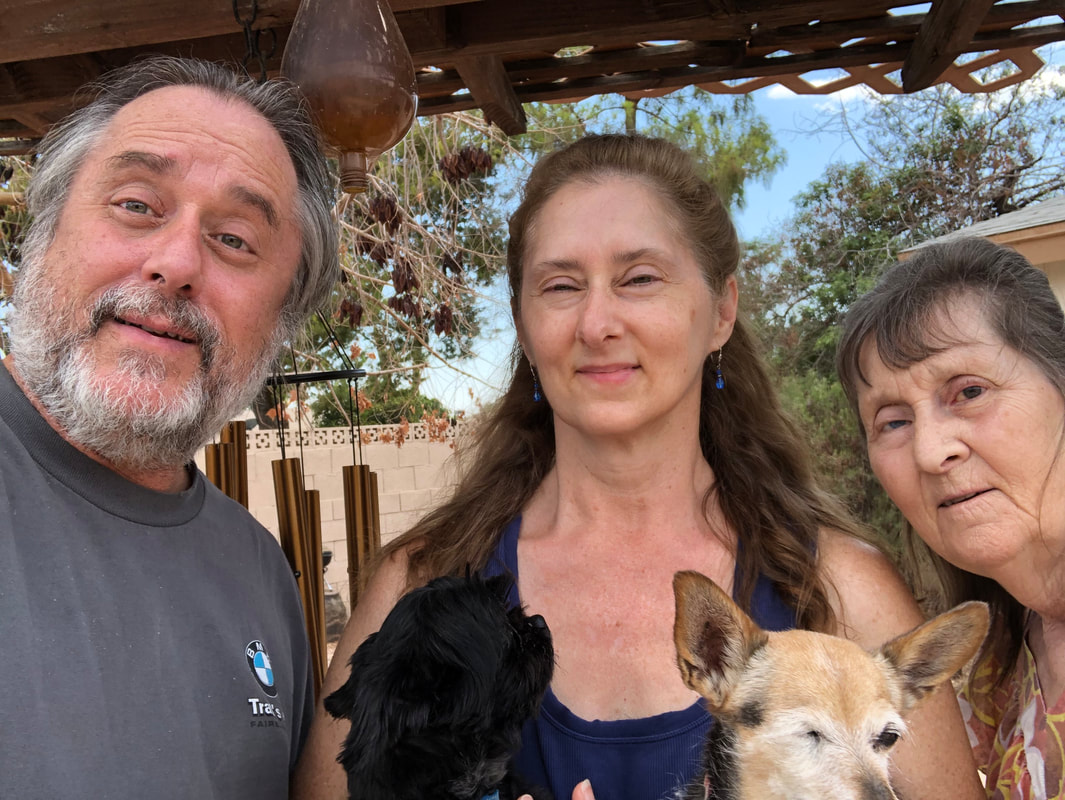
 RSS Feed
RSS Feed